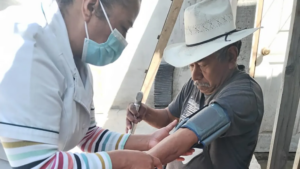
By Holland Bool
First published September 17, 2024 by Direct Relief
Natural disasters in Papua New Guinea, an island nation in Oceania, have killed and displaced thousands of people this year. These events have added new and urgent medical needs to an already overwhelmed health system coping with infectious and chronic diseases against a background of violence and instability.
A catastrophic landslide in May buried an entire community in the country’s central highlands, resulting in over 2,000 fatalities and affecting thousands of people. In March, a magnitude 6.9 earthquake struck in a remote northern region, killing five people and destroying more than a thousand homes across dozens of villages already inundated by widespread, severe flooding along the Sepik River.
Papua New Guinea is the most populated country in the Pacific Islands, but it is also heavily rural, complicating both health care access and emergency response efforts. Of its 10 million residents, 85% live in rural areas with extremely limited transportation infrastructure. Poverty affects 40% of the population.
Even before these disasters, the country faced a high incidence of infectious and vector-borne diseases like pneumonia, tuberculosis, malaria, typhoid, and diarrheal illnesses, many of which can be exacerbated by flooding and displacement. As in countries around the world, chronic diseases like diabetes and hypertension are a rapidly growing concern. Violent conflicts between tribes have led to repeated killings and added to instability.
Landslides, earthquakes, and flooding bring urgent health risks such as contaminated water — cholera outbreaks in the aftermath of these disasters are common — an increase in vectors like mosquitoes, immediate and long-term mental health disorders, and new opportunities for contagious diseases to spread, such as when people shelter in close quarters. Displacement and interruptions to health care can cause chronic diseases to spiral out of control, deprive people of nutritional support, and increase the risk of pregnancy and birth complications.
Direct Relief’s Response
Direct Relief has a long-standing relationship with Hope Worldwide, an international NGO working to increase health care capacity and access in Papua New Guinea, among many other projects. For Direct Relief’s emergency response team, this relationship provided a valuable opportunity to connect with the two local Public Health Authorities confronting disasters in their communities. The organization’s staff members worked with the PHAs to determine health care needs on the ground and coordinate support.
In response to these crises — and to bolster future response capabilities — Direct Relief deployed emergency medical backpacks, an emergency health kit, and a range of requested medicines and supplies to Enga’s and East Sepik’s PHAs.
Ongoing flooding in East Sepik brings a significant risk of cholera, a water-borne disease that can become deadly within hours but is easily and effectively treated with supportive care measures like hydration salts, IV fluids, and clean water. Direct Relief’s response also included a large-scale cholera treatment kit and 20,000 water filters that will be distributed to affected communities in East Sepik, with community health workers offering education and training to prevent water-borne illness.
In partnership with Hope Worldwide, Direct Relief is exploring new possibilities to bolster health capacity and make care more accessible in Papua New Guinea.
Related Articles

Adopting Hope: The Doctor Who Became Family to Children in Ethiopia
Dr. Rick Hodes, a spinal surgeon practicing in Ethiopia for decades, operates a program treating hundreds of patients annually with conditions ranging from scoliosis to tuberculosis-related deformities. Earlier in his career, Hodes adopted five children in order to get them life-altering medical care in the United States.

Critical Medicines Bolster Urgent Care in the Halls of an Evacuation Shelter
Direct Relief delivered requested medications to providers caring for displaced patients with urgent, severe conditions exacerbated by the Los Angeles County wildfires.

Health Care Hero: A Landfill Fire Was Poisoning Her Patients. She Cared for Them at Home.
For years, nurse Alejandra Hernandez Ezquivel has cared for patients in a rural community in eastern Mexico. A new primary care center, founded by Fundación Escala, is testament to her importance and dedication to her community. From Direct Relief.











